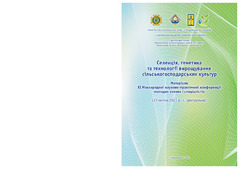Приказ основних података о документу
The effect of genotype on grain properties of different maize hybrids from Serbia
| dc.creator | Nikolić, Valentina | |
| dc.creator | Simić, Marijana | |
| dc.creator | Žilić, Slađana | |
| dc.creator | Sarić, Beka | |
| dc.creator | Milovanović, Danka | |
| dc.creator | Vasić, Marko G. | |
| dc.creator | Jovanović, Snežana | |
| dc.date.accessioned | 2023-10-16T07:28:48Z | |
| dc.date.available | 2023-10-16T07:28:48Z | |
| dc.date.issued | 2023 | |
| dc.identifier.uri | http://rik.mrizp.rs/handle/123456789/1181 | |
| dc.description.abstract | Maize (Zea mays L.) is, along with wheat and rice, one of the most important cereal crops in the world. The five basic groups of commercially available maize hybrids are dent, flint, floury, popping, and sweet maize. The grain color can also vary from white, yellow, and orange, to red, blue, purple and brown. The aim of this study was to investigate the effect of genotype on grain quality of 33 maize hybrids, including physical properties and grain chemical composition. The hybrids were grown in 2022 at the location of Zemun Polje, Serbia and tested in in the laboratory of the Department of Food Technology and Biochemistry of the Maize Research Institute “Zemun Polje“. Manual dissection of the grains indicated that the highest content of pericarp fraction was present in the popcorn genotype ZP 611k (10.38%), and the lowest in yellow dent genotype ZP 6066 (5.77%), the germ fraction was predominant in the sweet hybryd ZP 504su (16,09%),and the endosperm (84.13%) in popcirn genotype ZP 6119k. The 1000-kernel weight, an important physical indicator of grain quality, ranged from 120.98 g (popcorn hybrid ZP 617k) to 398.13 g (yellow dent ZP 7072). Higher 1000-kernel weight is a preferred wet-milling characteristic because it is associated with greater starch and protein yield and lesser yields of fiber. The findings indicate that the starch, protein, oil, crude fiber, and ash contents of 33 different maize genotypes varied between intervals: from 56.79% (sweet hybrid ZP 504su) to 70.38% (yellow dent hybrid ZP 4123); from 10.95% (yellow dent ZP 6566) to 13.28% (ZP 504su); from 3.14% (yellow popcorn ZP 611k) to 7.37 % (ZP 504su); from 1.89% (yellow dent ZP 457) to 3.45% (early ripening yellow dent ZP 161); and from 1.39% (yellow dent ZP 7777) to 1.80% (ZP 161), respectively. The investigated red kernel genotypes: ZP 3027r and ZP 5048r, as well as white kernel hybrid ZP 553w did not stand out significantly regarding the basic chemical composition, even though our previous studies showed that red genotypes contain health-promoting antioxidants – anthocyanins that provide the red color of the grain. These findings can be of great importance for future breeding programs directed toward creating new and improved genotypes of maize hybrids with superior grain quality traits intended for different purposes. | sr |
| dc.language.iso | en | sr |
| dc.publisher | Kiev : Ukrainian Institute for Plant Variety Examination | sr |
| dc.relation | info:eu-repo/grantAgreement/MESTD/inst-2020/200040/RS// | sr |
| dc.rights | openAccess | sr |
| dc.rights.uri | https://creativecommons.org/licenses/by/4.0/ | |
| dc.source | XI International applied science conference of young scientists and experts "Breeding, genetics and growing technology for agricultural crops" - Book of proceedings | sr |
| dc.subject | maize | sr |
| dc.subject | grain properties | sr |
| dc.title | The effect of genotype on grain properties of different maize hybrids from Serbia | sr |
| dc.type | conferenceObject | sr |
| dc.rights.license | BY | sr |
| dc.citation.spage | 89 | |
| dc.citation.epage | 90 | |
| dc.identifier.fulltext | http://rik.mrizp.rs/bitstream/id/6310/tez-23.indd-89,90.pdf | |
| dc.identifier.rcub | https://hdl.handle.net/21.15107/rcub_rik_1181 | |
| dc.type.version | publishedVersion | sr |


